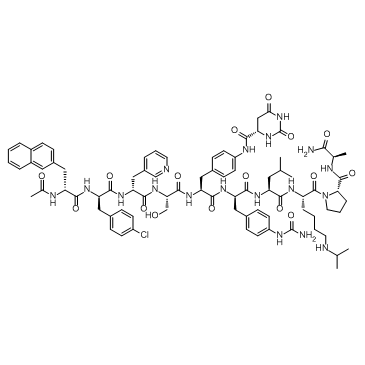Degarelix |
| Catalog No.GC35828 |
Degarelix is a competitive and reversible gonadotropin-releasing hormone receptor (GnRHR/LHRHR) antagonist.
Products are for research use only. Not for human use. We do not sell to patients.

Cas No.: 214766-78-6
Sample solution is provided at 25 µL, 10mM.
Degarelix is a competitive and reversible gonadotropin-releasing hormone receptor (GnRHR) antagonist. GnRHR[1]
Degarelix acts directly on the pituitary receptors for luteinizing hormone-releasing hormone (LHRH), blocking the action of endogenous LHRH. The use of degarelix eliminates the initial undesirable surge in gonadotropin and testosterone levels, which is produced by agonists of LHRH[1]. Degarelix treatment reduces cell viability in all prostate cell lines (WPE1-NA22, WPMY-1, BPH-1 cells, VCaP cells), with the exception of the PC-3 cells. The GnRH antagonist degarelix exerts a direct effect on prostate cell growth through apoptosis[2].
At single subcutaneous injections of 0.3 to 10 μg/kg in rats, degarelix produces a dose-dependent suppression of the pituitary-gonadal axis as revealed by the decrease in plasma luteinizing hormone (LH) and testosterone levels. Duration of LH suppression increases with the dose: in the rat, significant suppression of LH lasted 1, 2, and 7 days after a single subcutaneous injection of degarelix at 12.5, 50, or 200 μg/kg, respectively[3]. Degarelix is stable when incubated in microsomes and cryopreserved hepatocytes from animal liver tissue. In rat and dog, most of the degarelix dose is eliminated within 48 h via urine and feces in equal amounts (40-50% in each matrix), whereas in monkey the major route of excretion is fecal (50%) and renal (22%)[4].
[1]. Rick FG, et al. An update on the use of degarelix in the treatment of advanced hormone-dependent prostate cancer. Onco Targets Ther. 2013 Apr 16;6:391-402. [2]. Sakai M, et al. In search of the molecular mechanisms mediating the inhibitory effect of the GnRH antagonistdegarelix on human prostate cell growth. PLoS One. 2015 Mar 26;10(3):e0120670. [3]. Broqua P, et al. Pharmacological profile of a new, potent, and long-acting gonadotropin-releasing hormoneantagonist: degarelix. J Pharmacol Exp Ther. 2002 Apr;301(1):95-102. [4]. Sonesson A, et al. Metabolite profiles of degarelix, a new gonadotropin-releasing hormone receptor antagonist, in rat, dog, and monkey. Drug Metab Dispos. 2011 Oct;39(10):1895-903.
Average Rating: 5 (Based on Reviews and 16 reference(s) in Google Scholar.)
GLPBIO products are for RESEARCH USE ONLY. Please make sure your review or question is research based.
Required fields are marked with *




















